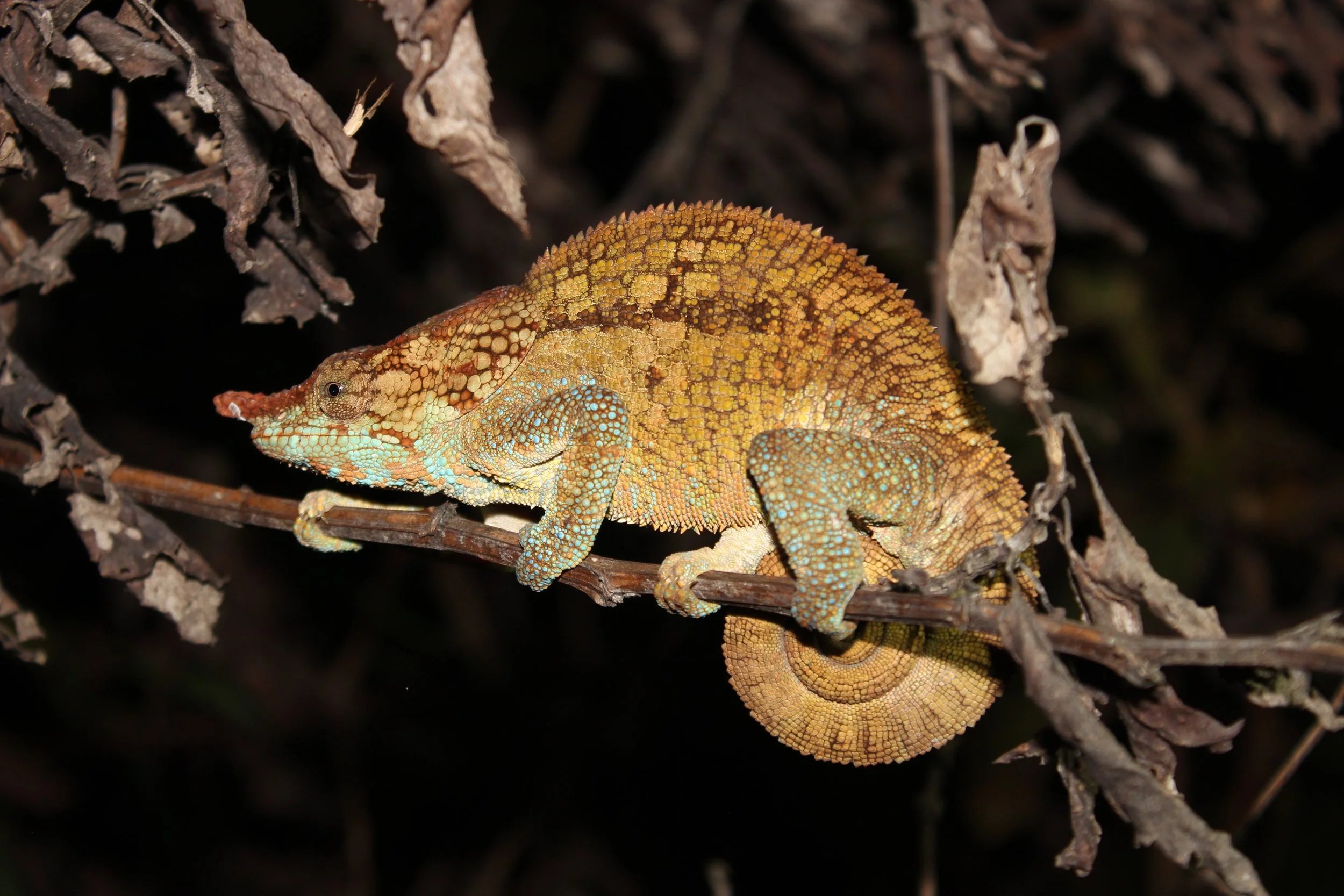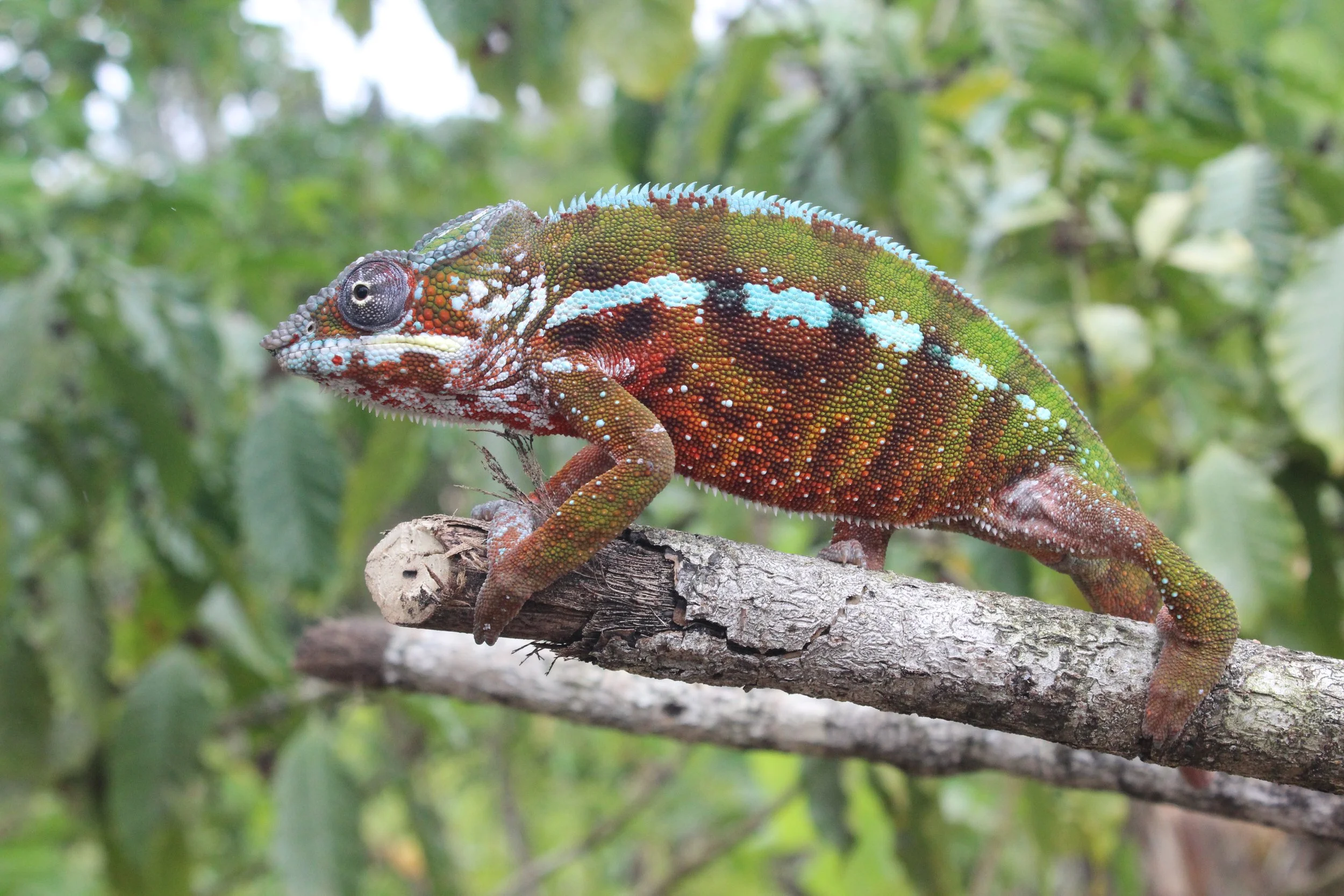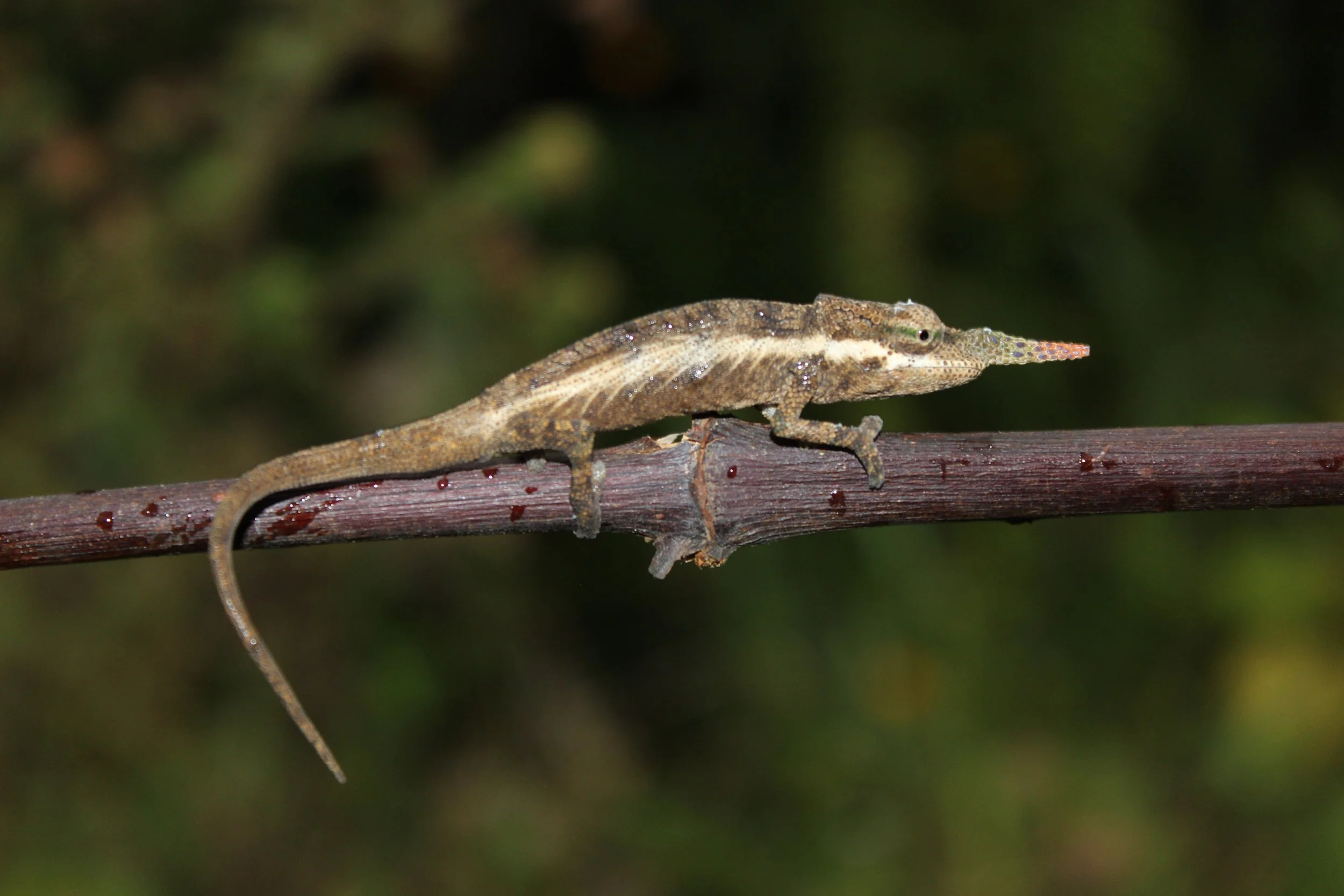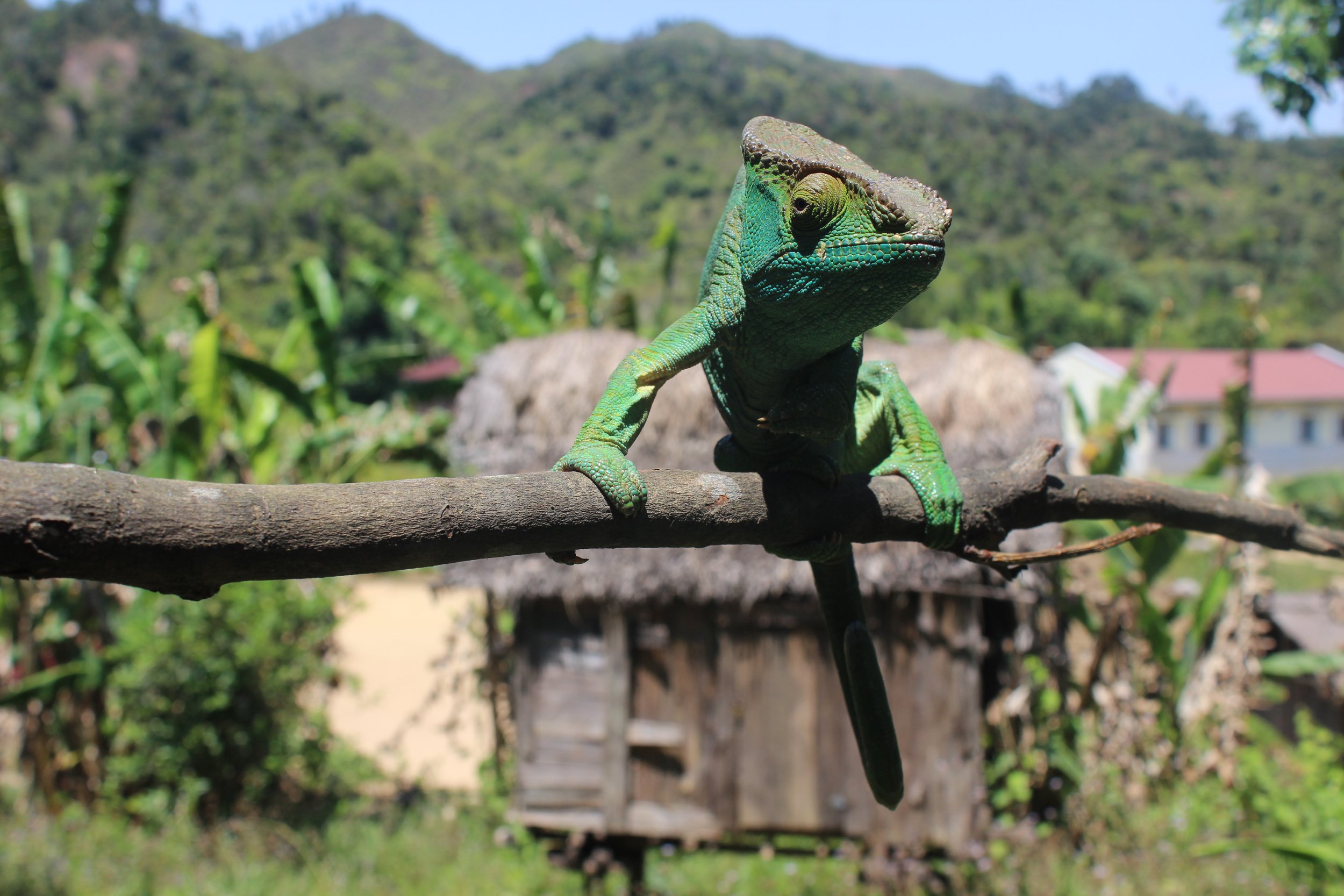The Chameleons of Madagascar: An Overview
Madagascar is home to around 100 species of chameleons. These include the ‘Brookesia’ leaf chameleons, the enormous Parson’s chameleons (Calumma parsonii ssp.) and just about every conceivable variation between. Falling into the Brookesia, Calumma, Furcifer and Palleon genera, the chameleons of Madagascar display a stunning array of variations from unique species-specific adaptations to mind-boggling locality variants. On a recent trip to Madagascar, I was fortunate enough to find and photograph many of these unique lizards across a variety of habitats.
Madagascar’s geography
Madagascar, like many species-rich regions across the world, is split by a central ridge of high-altitude mountains that produces a variety of habitats. To the East of the central highlands is a stretch of rainforest with different areas experiencing different amounts of rainfall. These mixed-altitude forests produce a dizzying array of habitats from the moss-drenched humid forests of Ranomafana to the much drier primary forests of Andasibe. These regions tend to hold the greatest biodiversity on the island, but only occupy a narrow strip of land covering just a small fraction of the country itself. To the south of the central highlands is a much drier savannah habitat akin to its longitudinal neighbour, Mozambique and South Africa. The West of Madagascar is also reasonably dry, but far more forested, with interesting rock formations and iconic baobab trees. This is the region that most tourists see in their travel brochures, but interestingly hosts some of the most fragile and localised of all chameleon species. North Madagascar is characterised by a wide range of habitats as the central highlands give way for an amalgamation of different elevations and climates. The biodiversity in the North, whilst often widespread, is completely different to that of the south. Some of the most popular captive Madagascan species, such as Furcifer pardalis, phelsuma grandis and Dyscophus sp. are most commonly associated with the North.
Central Highlands
The central highlands host several interesting chameleon species. Some can even be found in urban locations around Antananarivo, the capital city of Madagascar. There are officially 1.3 million people living in this city (though it is assumed the actual number is at least double this statistic) and there are few green spaces. The city is mostly plagued with non-native Jacaranda trees (Jacaranda mimosifolia) and many natural resources are utilised to build temporary homes. On the outskirts, where the Ikopa River dissects the city and within regions of neighbouring gardens, one the most colourful of all chameleons can be found, furcifer lateralis – the carpet chameleon. Whilst males are generally green with a few dorsal patterns, females are extremely colourful exhibiting blue, yellow, white and orange patterns. The females are most colourful when gravid. Growing to an average of 20cm, these medium-sized chameleons are quick to mature. They reach adulthood within just three months and lay clutches of around 10-20 eggs three times a year. The stable temperatures of urban environments create the perfect biological niche for these chameleons and some research (Bartlett & Bartlett) suggests the carpet chameleon is benefitting from habitat alteration. In one region of Antananarivo, we found a carpet chameleon on every shrub, totalling half a dozen in a short walk from the hotel to the local market (and another three in the hotel grounds). Although tribal communities’ perceptions of chameleons differ across regions, Malagasy children in Antananarivo will often catch these abundant lizards to show tourists in hope of a tip. Furcifer lateralis can also be found across most of the central highlands and arid regions of the East.
The second most populous chameleon in the highlands is the Oustelet’s chameleon (Furcifer oustaleti) or ‘Malagasy giant chameleon’. It is in fact, the longest of all chameleons. Whilst Parson’s chameleons (Calumma parsonii parsonii) are far heavier, much bulkier and visually ‘larger’ than Oustaleti, the immensely-long prehensile tail of this species makes it a solid contender for ‘longest’. The Oustalet’s chameleon is characterised by distinct spines down its crest and an almost weathered appearance. Browns and greys can sometimes make way for dazzling white and orange patterns, but this species is generally more cryptic in colouration than other chameleons. We found most Oustaleti on robust branches overhanging steep drops close to running water. This is a perfect example of the bold personalities of reptiles that have almost nothing to fear in a region without significant threats from predators.
Outside of the city, there are many more species that call the central highlands ‘home’. The lesser chameleon (Furcifer minor) is a species that takes sexual dimorphism to an entirely new realm. To the untrained eye, the females and the males could be entirely different species. Males possess rostral horns, have drab colouration and can reach up to 24cm in length. Females, on the other hand, are a vivid green and can produce beautiful yellow and black patterns and rarely exceed 15cm in length. This species is considered ‘Endangered’ by the IUCN as it requires tapia forest dominated by the Uapaca bojeri tree. Unfortunately, this dry forest habitat is constantly falling victim to slash-and-burn farming to make way for rice plantations. It now only lives in the Itremo region of Madagascar as most habitat has been replaced by unsuitable grassland. In these regions, they are reasonably populous, and we managed to find one male and one female after a few hours of searching. Despite them being documented as territorial and solitary chameleons, both lizards occupied the same tree, less than three meters away from one another, suggesting they might be a breeding pair.
Some species found in the central highlands of Madagascar look very similar. The short-horned chameleon (Calumma brevicorne) is widespread across mid-elevations between 810 and 1000m and is extremely common in both dry and tropical forests. Their close relative Calumma crypticum (possibly named due to its cryptic similarity to brevicorne) looks almost identical and occupies many similar habitats. Both have heterogeneous scales, rostral appendages, and occipital lobes. For those that are not taxonomists, this means “random scale patterns, a protruding nose and flaps on the side of their heads.” Each species is best characterised by its colouration, which (being chameleons) is often difficult to pinpoint. However, male Calumma crypticum will turn a majestic pastel blue with orange and brown stripes when introduced to a female – giving it its localised common name the “blue-legged chameleon.” We were very lucky to witness one male exhibiting breeding behaviour and managed to photograph this startling colour change.
Mixed-altitude rainforest
Ranomofana National Park is one of, if not the most biodiverse area in Madagascar. Mixed altitudes set amongst rich evergreen forests play host to a range of endemic and endangered lemur species, as well as birds, invertebrates, amphibians and of course, reptiles. Dozens of chameleon species can be found in the forest, but the most abundant species is perhaps Calumma nasutum. This species (which has been given the common name of ‘pimple-nosed chameleon’) rarely exceeds 5cm SVL (snout to vent) length. They are mostly found tenderly holding stems of plants, where they will rest underneath broad leaves. Whilst many Malagasy animals can live a life without fear of large predators, everything is a ‘large predator’ to Calumma nasutum – even praying mantis and small birds. It is thought that nasutum is a species complex, meaning that with further study more species are likely to be distinguished from this species. As it is extremely widespread and shares much of its distribution with another tiny chameleon we found along the way, Calumma fallax, this certainly rings true. Male fallax are identifiable by larger, more heterogenous scale patterns but are extremely difficult to distinguish from nasutum. This makes conservation efforts even more important across tropical Madagascar, as even though Calumma nasutum is considered ‘Least Concern’ by the IUCN, a disregard for its conservation in remote areas may lead to the extinction of new species before they are even described.
In stark contrast to the tiny species, the world’s largest chameleon, the parson’s chameleon (Calumma parsonii) also calls Ranomafana home. Although parson’s chameleons are widely distributed across the Eastern lowlands, the lower altitude regions of Ranomafana play host to a unique locality form – the ‘yellow-lipped’ parson’s chameleon (Calumma p. parsonii). Ranomafana in Southeast Madagascar comprises the most southernly point in the parson’s distribution. Further North, the ‘orange-eyed’ nominate form C. p. parsonii and the subspecies C. p. cristifer can both be found. Cristifer are generally smaller and less colourful than parsonii parsonii. Still, all subspecies are extremely impressive in size and appearance. They are the world’s largest chameleons, the longest-lived of all chameleons and have the longest incubation period of all reptiles, which can last up to 660 days! Once a clutch of eggs is laid, there can be up to one month between the first and the final egg hatching. We were lucky to be in East Madagascar during this time (which usually lasts from September to November) and witnessed almost a dozen juvenile Parson’s chameleons. In one case, three hatchlings (no more than two weeks old) had perched themselves on branches of the same tree. Hatchlings are just a few inches long and thus, at risk of predation from birds and other reptiles. The mother Parson’s compete with these odds by producing around 50 - 60 eggs. Previously, it was thought that an average clutch contained around 30-35 eggs. With more hobbyists and zoological institutions successfully breeding the species in captivity, herpetologists have confirmed parsonii parsonii can lay up to 70 eggs in a single clutch. Interestingly, this incubation period requires fluctuations in temperatures, with alternating hot and cold periods for success. Emerging literature is having a positive impact on the captive breeding of C. p. parsonii.
Although the wet rainforests of the southeast were (in our experience) largely dominated by Calumma species, there were some Furcifer species also. The most common of which was the belted chameleon (Furcifer balteatus). This species gets its name from a distinct band that runs down its dorsum and is sometimes referred to as the ‘twin-banded’ chameleon. Despite being relatively abundant in Ranomafana, it is an endangered species and can be found nowhere else in the world. There may be a second population further south, but habitat fragmentation means the mid-altitude forests of Ranomafana are the last stronghold for this species. They are reasonably drab in colouration, sporting a uniform green or olive appearance. However, this changes entirely during territorial conflict. Balteatus, when assuming a defensive posture, is one of the most visually striking of all chameleons. Their bands become so distinct and contrasted that they could be easily mistaken for a plastic toy or a character from a Pixar film. Upon finding two males and a single female in a nearby tree, we introduced both males to document this colour change. As an endangered species that is rarely if ever kept in captivity, there are few records of this behaviour.
A third and relatively new genus of chameleon can also be found on the forest floors of south-eastern Madagascar. Formerly Brookesia nasus, Palleon nasus is a species of leaf chameleon no longer than 8cm in length. The genus Palleon, meaning old (Palea) and lion (leon) was formed in 2013 to describe two species of leaf chameleon that are genetically distinct from Brookesia. The ‘old’ (Palea) refers to the evolutionary distinction of this genus millions of years ago. Leaf chameleons are perhaps some of the most fragile of all chameleons and both members of the Palleon genus are considered “vulnerable.”
Although most species of chameleon we encountered were numerous, albeit restricted in their range, there were several that we only found once. In the southeast, the most notable must be Calumma glawi. This is an endangered species with a highly restricted range. There are several species, mostly found in the North, that have unique body shapes for chameleons. The first of which to be described was Calumma furcifer in 1880. This slender-bodied Calumma species adopts traits from both genera. Calumma glawi was described more recently in 1997. It has a low casque, but a long skull shape reminiscent of some Anolis species. It is named after the German herpetologist Frank Glaw, who has described several dozen Malagasy species and whose work with Miguel Vences on “A Field Guide to the Reptiles and Amphibians of Madagascar” remains the most comprehensive publication on Madagascar’s herpetofauna to date. Calumma glawi prefers very dense primary rainforest at mid-altitudes between 300-800m, these “constantly wet” environments are characterised by rich vegetation and thick layers of moss.
Ranomafana National Park, despite being “protected” has seen considerable deforestation in recent years. Although there is less slash-and-burn farming than elsewhere in the country, even within the park’s boundaries there is an alarming rate of controlled burns. The biodiversity in this region is also largely dictated by altitudes, meaning some species inhabit small pockets of lowland forests while others thrive high in the mountains. Even if a species occurs within the park’s boundaries it does not necessarily occupy the entirety of the 161 miles2 that is supposedly protected. This unfortunately means that many of the chameleons in this region are still at high risk of extinction within the coming years, despite seemingly abundant numbers within the rainforest.
Eastern lowlands
A much sadder story is being told in the East of Madagascar, where slash-and-burn farming is entirely unregulated and huge acres of forest are being burned every day. We travelled from the East to the North for just a few days and returned to find entire regions burned and scenic photographs almost unrecognisable. This included a region where critically endangered golden mantella (Mantella aurantiaca) were previously found. Although Andasibe-Mantadia National Park loosely protects some land and several NGOs are working to conserve other areas, the eastern tropical forests of Madagascar are extremely vulnerable and so to are its inhabitants.
Perhaps the most interesting of all is Calumma gallus, the Pinocchio chameleon. Sexual selection has caused males of this species to develop a very long rostral appendage. Although these chameleons are extremely small, a close look at their ‘nose’ shows a vibrant two-tone colouration amongst their scales. Although the species is generally drab in colour, the male’s rostral protrusion can be a brilliant blue or green with a vibrant red tip. The male’s nose is also extremely fleshy and houses no bones or adapted skull shape. This supports the theory that it evolved reasonably quickly through sexual selection and has no real use in territorial disputes like other ‘horned’ chameleons. Females have a much smaller rostral appendage that is typically red. The Pinocchio chameleon is reliant on a very specific habitat, so it took several attempts to find and photograph one. They generally inhabit steep slopes rich in secondary vegetation and ferns. Like many smaller species, they are inconspicuous with their basking behaviours and therefore perch themselves within the centre of shrubs and bushes. This ensures that they can thermoregulate effectively, whilst avoiding predatory snakes and birds. Other species also call this dry, sloped habitat home. For example, Furcifer bifidus are abundant in these areas and are considered ‘least concern’ by the IUCN as they can occupy secondary vegetation across a wide distribution stretching from the Andasibe region, right up to the north coast.
Later, we visited a small patch of forest near Vohidrazana in search of the world’s smallest “true” chameleon. Calumma roaloko, sometimes referred to as the two-toned soft-nosed chameleon, was only described in 2018. Its name comes from the Malagasy “roa” meaning “two” and “loko” meaning “colour” and references the two-toned colouration of both the males and the females. It is a member of the “boettgeri” complex and shares many similarities. In fact, females are almost impossible to distinguish. Sadly, this species only lives in a tiny patch of rainforest that acts as a corridor in the Ankeniheny-Zahamena forest. Finding it requires several hours of trekking on narrow paths, into a reserve managed by the NGO, GERP (which focuses most of its initiatives on Indri lemurs). Few tourists visit this location, however, our guide Patrick Andriamihaja was thought to be one of the first people to photograph the species before it was officially described by Protzel et al in October 2018. At the location, we found two specimens, a male and a female. As the smallest member of the Chamaeleoninae subfamily, it is considered the smallest ‘true’ chameleon in the world and rarely reaches 4.5cm SVL and never exceeds 10cm in total length. There have been no studies leading to an official conservation status of this species yet. However, the rampant forest fires that shrouded the habitat of this delicate species paint a worrying picture. Whilst GERP may be protecting some habitat within this species’ range, one uncontrolled burn could theoretically put an end to the world’s smallest chameleon.
The drier forests of central/eastern Madagascar play host to other tiny “chameleons”. Brookesiinae is a subfamily of chameleons belonging to Chamaeleonidae family but distinct from the Chamaeleoninae subfamily (slightly confusing, I know!) Most Brookesia diversity is concentrated in the North and West of Madagascar, where the climate is far more arid. However, several species can be found in the tropical rainforests in the East. The two most common are Brookesia superciliaris and Brookesia therezieni. The former is found across the majority of the East side of the country and is reasonably adaptable, living life amongst the leaflitter of both dry and humid forests. The latter inhabits similar ecosystems stretching north from Andasibe. They, like most species of Brookesia, are diurnal and will actively move through leaflitter searching for tiny insects during the day. However, they will roost on low-lying vegetation at night, making them far easier to spot. During the rainy season, pairs can be seen roosting close to each other suggesting that these animals may have complex mating rituals. Perhaps their most unique feature after their cryptic appearance is their defence strategies. Although most chameleon species are reasonably bold when approached by a would-be predator (or inquisitive herpetologist) and adorn themselves with vibrant colouration, threatening lobe displays or a striking open-mouthed posture, Brookesia are far more subtle. If so much as a roosting branch is disturbed, Brookesia will simply freeze and drop from their place of rest. They will curl their arms up into their body to “play dead” and roll into the leaf litter below, hoping their excellent camouflage will prevent them from being preyed upon. Some species of leaf chameleon also vibrate and thrust their spines perhaps to simulate a leaf in the wind. Brookesia superciliaris was the first species of Brookesia to be described and was named by Kuhl in 1820. Although we only found therezieni (a member of the superciliaris complex) in this region, superciliaris likely contains several yet-undescribed species.
Deforestation in Madagascar
According to Global Forest Watch, in the last 10 years, Madagascar has lost over 14% of its total humid forest and over 21% of its total tree cover. This has happened during a time when deforestation and environmentalism are becoming a growing concern worldwide. Shockingly, 2017 and 2018 saw the highest levels of deforestation that the country has ever seen. It is very difficult to fully articulate the extent to which Madagascar is being, essentially, burned down. Over 18 days, around 1750km of travelling and several jungle treks (to some very remote locations), there was not a single moment that I couldn’t see or smell a forest fire.
The socio-economic politics that dictate the development of this independent island are complicated. However, from a purely ecological perspective, Madagascar's delicate flora and fauna are under serious threat. During the expedition, we found and photographed 98 species of reptiles and amphibians, 23 of which were chameleons. A quarter of these are considered endangered, two are ‘data deficient’ and several are likely to include new species not yet known to science. Yet, agricultural development in Madagascar continues to pose a serious threat.
The influx of deforestation is particularly sad given the Malagasy relationship with wildlife. Although there are numerous communities across the country that hold a diverse array of beliefs, the relationship between Malagasy people and reptiles is epitomised by respect. Some communities believe that animals, including snakes, hold the spirits of lost loved ones. Other communities consider chameleons as “fady” (meaning ‘taboo’) which prevents them from killing them. In my limited time in Madagascar, I did not see a single bushmeat market, exotic ‘street food’ stand or any commodification of animals for tourist trinkets. This is far removed from other developing countries that I have visited. Perhaps this respect for wildlife formed from a lack of harmful species or perhaps curiosity from early Pacific Island settlers. Either way, the harm that is being enacted upon Madagascar’s unique flora and fauna stems ultimately from a need to survive and a lack of education. Unsustainable farming practices inevitably take hold in countries where education is limited, simply because it is the ancestral way of ensuring food is placed on the table.
Eco-tourism may hold some hope for Madagascar. It has worked in Central and South American countries. However, the success of these initiatives in places like Costa Rica is partly due to government support schemes. Madagascar does not have the same infrastructure for tourism and in some cases, tourists are being redirected to islands such as Nosy Be where officials own large holiday resorts. The financial input from tourists therefore never reaches the farmers, giving them no initiative to protect the rainforest. Joining herpetological expeditions, working with local guides and visiting countries to show that there is a demand to see wildlife may have a very positive impact in the future. If just one small village can make more of an income from tourists interested in a particular species of chameleon than they would from selling rice or digging clay for bricks, they are far more likely to protect their natural resources. Madagascar banned the exportation of all wildlife in 2019. Now, licences and permits are required to export many plant species also. This has removed some of the motivation to maintain natural habitats and supporting NGOs and ecotourism initiatives may be one of the last ways of adding financial value to wild Madagascar.





